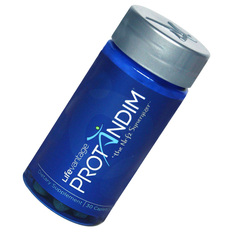|
PROTANDIM A scientific breakthrough in reducing oxidative stress. It is the most important dietary supplement of our time. Here is how Protandim works. Our bodies are attacked by free radicals every day. Free radicals can damage cells and are believed to accelerate the progression of cancer, cardiovascular disease, and age-related diseases. Protandim through Nrf2 activation reduces oxidative stress by 40% in 30 days. |
|
Oxidative stress is caused by an imbalance between the production of reactive oxygen and a biological system's ability to readily detoxify the reactive intermediates or easily repair the resulting damage.
All forms of life maintain a reducing environment within their cells. This reducing environment is preserved by enzymes that maintain the reduced state through a constant input of metabolic energy. Disturbances in this normal redox state can cause toxic effects through the production of peroxides and free radicals that damage all components of the cell, including proteins, lipids, and DNA. |
Nrf2 is a powerful protein that is latent within each cell in the body, unable to move or operate until it is released by an Nrf2 activator.
Once released it migrates into the cell nucleus and bonds to the DNA at the location of the Antioxidant Response Element (ARE) which is the master regulator of the total antioxidant system available in ALL human cells. |
|
Protandim activates Nrf2, instructing the cell to make more protective, survival-related enzymes. Some of these enzymes that get turned on in our body (Glutathione, Catalase, and Superoxide Dismutase) fight oxidative stress. Direct antioxidants such as vitamin C, vitamin E, blueberries, and acai berries eliminate free radicals 1:1.
|
Taking only one Protandim capsule each day increases the enzymes in your body that can eliminate 1,000,000 free radicals per second, every second.
An analogy often used to describe the effectiveness of Protandum is, your body is like a house on fire. - A direct antioxidant is like throwing a cup of water on the burning house to put out that fire. - Protandum is like having a fire hose in every room of the house putting out that fire! |
What is Nrf2- The Master Regulator?
Nrf2 is a powerful protein that is latent within each cell in the body, unable to move or operate until it is released by an Nrf2 activator. Once released it migrates into the cell nucleus and bonds to the DNA at the location of the Antioxidant Response Element (ARE) or also called Human Antioxidant Response Element (HARE) which is the master regulator of the total antioxidant system that is available in ALL human cells.
“High levels of free radicals turn on a specific protein in the cell’s nucleus called Nrf2. Activation of Nrf2 essentially opens the door for the production a vast array our body’s most important antioxidants.
Nrf2 is a powerful protein that is latent within each cell in the body, unable to move or operate until it is released by an Nrf2 activator. Once released it migrates into the cell nucleus and bonds to the DNA at the location of the Antioxidant Response Element (ARE) or also called Human Antioxidant Response Element (HARE) which is the master regulator of the total antioxidant system that is available in ALL human cells.
“High levels of free radicals turn on a specific protein in the cell’s nucleus called Nrf2. Activation of Nrf2 essentially opens the door for the production a vast array our body’s most important antioxidants.
Understanding Free Radicals and Antioxidants.
Normally, bonds don’t split in a way that leaves a molecule with an odd, unpaired electron. But when weak bonds split, free radicals are formed. Free radicals are very unstable and react quickly with other compounds, trying to capture the needed electron to gain stability. Generally, free radicals attack the nearest stable molecule, "stealing" its electron. When the "attacked" molecule loses its electron, it becomes a free radical itself, beginning a chain reaction. Once the process is started, it can cascade, finally resulting in the disruption of a living cell.
Some free radicals arise normally during metabolism. Sometimes the body’s immune system’s cells purposefully create them to neutralize viruses and bacteria. However, environmental factors such as pollution, radiation, cigarette smoke and herbicides can also spawn free radicals.
Normally, the body can handle free radicals, but if antioxidants are not available, or if the free-radical production becomes excessive, damage can occur. Of particular importance is that free radical damage accumulates with age.
In summary: An atom or group of atoms that has at least one unpaired electron and is therefore unstable and highly reactive. In animal tissues, free radicals can damage cells and are believed to accelerate the progression of cancer, cardiovascular disease, and age-related diseases.
Normally, bonds don’t split in a way that leaves a molecule with an odd, unpaired electron. But when weak bonds split, free radicals are formed. Free radicals are very unstable and react quickly with other compounds, trying to capture the needed electron to gain stability. Generally, free radicals attack the nearest stable molecule, "stealing" its electron. When the "attacked" molecule loses its electron, it becomes a free radical itself, beginning a chain reaction. Once the process is started, it can cascade, finally resulting in the disruption of a living cell.
Some free radicals arise normally during metabolism. Sometimes the body’s immune system’s cells purposefully create them to neutralize viruses and bacteria. However, environmental factors such as pollution, radiation, cigarette smoke and herbicides can also spawn free radicals.
Normally, the body can handle free radicals, but if antioxidants are not available, or if the free-radical production becomes excessive, damage can occur. Of particular importance is that free radical damage accumulates with age.
In summary: An atom or group of atoms that has at least one unpaired electron and is therefore unstable and highly reactive. In animal tissues, free radicals can damage cells and are believed to accelerate the progression of cancer, cardiovascular disease, and age-related diseases.
How antioxidants may prevent against free radical damage.
Antioxidants neutralize free radicals by donating one of their own electrons, ending the electron-"stealing" reaction. The antioxidant nutrients themselves don’t become free radicals by donating an electron because they are stable in either form. They act as scavengers, helping to prevent cell and tissue damage that could lead to cellular damage and disease.
Vitamin E
The most abundant fat-soluble antioxidant in the body. One of the most efficient chain-breaking antioxidants available.
- Primary defender against oxidation.
- Primary defender against lipid peroxidation (creation of unstable molecules containing more oxygen than is usual).
Vitamin C
The most abundant water-soluble antioxidant in the body. Acts primarily in cellular fluid. Of particular note in combating free-radical formation caused by pollution and cigarette smoke. Also helps return vitamin E to its active form.
Antioxidants neutralize free radicals by donating one of their own electrons, ending the electron-"stealing" reaction. The antioxidant nutrients themselves don’t become free radicals by donating an electron because they are stable in either form. They act as scavengers, helping to prevent cell and tissue damage that could lead to cellular damage and disease.
Vitamin E
The most abundant fat-soluble antioxidant in the body. One of the most efficient chain-breaking antioxidants available.
- Primary defender against oxidation.
- Primary defender against lipid peroxidation (creation of unstable molecules containing more oxygen than is usual).
Vitamin C
The most abundant water-soluble antioxidant in the body. Acts primarily in cellular fluid. Of particular note in combating free-radical formation caused by pollution and cigarette smoke. Also helps return vitamin E to its active form.
sources: News Medical, HealthCheck Systems, US National Library of Medicene- National Institutes of Health,
To learn more about LifeVantage peer review studies and their validation, and Dr. Joe McCord who is acknowledged as the science behind Protandim, click here.
LifeVantage Corp is publicly traded: NASDAQ: LFVN


